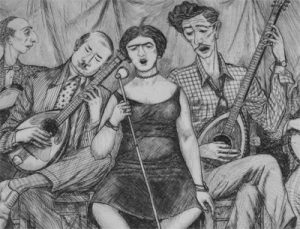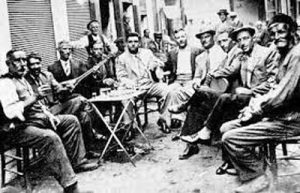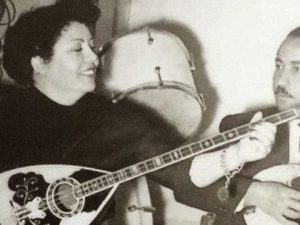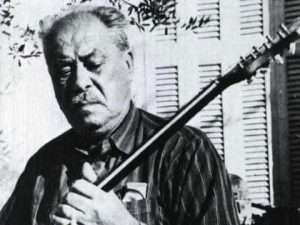History of the Rebetiko songs
 Rebetiko is the name of the Greek urban song that appeared at the end of the 19th century in the ports of Greek cities (Piraeus, Thessaloniki, Volos, Ermoupoli, Smyrna, Constantinople) – where the working class lived – and which acquired its familiar form until the third decade of the 20th century, after it also passed to other large urban centers.
Rebetiko is the name of the Greek urban song that appeared at the end of the 19th century in the ports of Greek cities (Piraeus, Thessaloniki, Volos, Ermoupoli, Smyrna, Constantinople) – where the working class lived – and which acquired its familiar form until the third decade of the 20th century, after it also passed to other large urban centers.
The rebetiko song was born by people of lower social groups as a reaction to the urbanization observed in the ports and urban centers and expresses the woes, desires and perceptions of marginal individuals, who were characterized or self-characterized as rebetes.
At this time, the gialadikas appear in Piraeus as proto-rebetika. These are named after the repeated phrase yala-yala, or aman-yala or yaleleli.
It is noteworthy that the rebetes called their songs folk songs. Elias Petropoulos, who published the book Rebetika in 1968, defines them as small, simple songs sung by ordinary people, the rebetes.
Although primarily erotic, rebetikas are deep down rather social songs. After all, the rebetes were also called dudes.
So these dudes often improvised lyrics and notes and used catchwords as well as their own dialect, slang, to avoid being understood by everyone. Also the rebetika were known as magika, mortika, seretika, murmurika, kutsavakika, etc.
What is the meaning of the word Rebetiko
 The word rebetis is probably of Turkish origin (rebet = mischievous, disobedient). According to some interpretation, the word rebetis means vagabond.
The word rebetis is probably of Turkish origin (rebet = mischievous, disobedient). According to some interpretation, the word rebetis means vagabond.
It probably comes from the Serbian word rebet, meaning rebel, or even from the Venetian word rebelo or the Spanish rebelde, also meaning rebel, unruly.
According to another version, the word is etymologically related to the medieval verb rembomai, which we also find in Erotokritos, and means to turn, to be proud, to admire.
Rebetico in modern times
 The rebetiko song, which has now entered the consciousness and everyday life of modern Greeks regardless of their social class and intellectual level, was not always a given as a self-evident Greek tradition.
The rebetiko song, which has now entered the consciousness and everyday life of modern Greeks regardless of their social class and intellectual level, was not always a given as a self-evident Greek tradition.
It was considered particularly misunderstood, which is why strong reactions initially erupted against it, which started from Athens.
The first argument against the rebetiko had to do with its origin. It was a remnant of the long-term Turkish slavery, which did not match the Greek reality.
The second was related to his thematics, which were related to the refugee, to the search – by any means – for better luck and survival, to love and prison and even to the underworld.
These arguments were not strong, but the reaction was strong, since the opponents of rebetiko had access to the means of shaping public opinion.
However, Rebetika music was to enter the life of the Greeks and strongly influence it to this day…
Periods of Rebetiko music
1922-1932: Period of dominance of Smyrna’s verses
It is certain that the rebetiko song begins to take shape after 1922, the year of the Asia Minor disaster.
With the forced exchange of populations, dictated by the Treaty of Lausanne, many Asians settled in the large urban centers of Greece.
They are cosmopolitans with broad education and expanded intellectual horizons, who brought with them the morals, customs and musical traditions from the Lost Homelands. t is the time when elements from the music of Smyrna and Constantinople and the east in general dominate the rebetiko song.
During this time ece knows about kafodeias and aman cafes, where refugees and locals alike flock to listen to rebette singers glorify
love, to refer to prisons – a basic motif in the rebetik’s thematics – to express the problems and sufferings of their daily life – mainly as a refugee.
1932-1942 Classic period of rebetiko song
 During the second period of the rebetik song, the first rebetik company appears, the famous Tetras of Piraeus,
During the second period of the rebetik song, the first rebetik company appears, the famous Tetras of Piraeus,
Consisting of great creators such as Markos Vamvakaris (from Syros), Giorgos Batis (from Piraeus), Anestis Delias (from Smyrna) and Stratos Payoumtzis (from Asia Minor).
This expresses in the most authentic way the theme of rebetiko, which is currently expanding. While during the first period of rebetik singing the main musical instrument was the santouri, the main instruments of the rebetiks of the classical period are the accordion, the bouzouki, the baglamadaki and the guitar, while the spoons and ziliyas are also used as percussion instruments.
One of the most well-known songs of the time is Fragosyriani by Markos Vamvakaris, who became the father of the rebetiko song. Another top artist in the field of Rebetiko was Vasilis Tsitsanis.
1942-1952: Era of mass acceptance of rebetiko song
 In the third period of its history, rebetiko is fortunately decriminalized, liberated, established as folk music acceptable to the wider masses and demarginalized, its poetic style is enriched, while its creator is now always named.
In the third period of its history, rebetiko is fortunately decriminalized, liberated, established as folk music acceptable to the wider masses and demarginalized, its poetic style is enriched, while its creator is now always named.
Vassilis Tsitsanis remains the main representative of the rebetiko song. loudy Sunday, taken out of the clouds of the occupation, captivated us all, says its composer Vassilis Tsitsanis, who began its composition in Thessaloniki during the Occupation (1943) and completed it in Athens (1948).
In the field of rebetiko, the following representatives stood out: Apostolos Hatzichristos (False Dounia, 1951), Yiannis Papaioannou (My Angel, Faliriotissa, 1936), Giorgos Mitsakis (A boat from Peraia, duet with Sotiria Bellou and Stellakis Perpiniadis) , Apostolos Kaldaras (Eviva, rebetes, 1947).
Dimitris Gogos – known as Bayanderas and the youngest son of a family with 23 children – writes Hatzikyriakeio, which refers to a well-known district of Piraeus.
After all, the song “Eimaste alania” lyrics by Evgenia Papagiannopoulou, music by Vassilis Tsitsanis and first musical performance by Prodromos Tsousakis (1951) was also a hit.
The minore tis Aygis, lyrics by Mino Matsa, music by Spyros Peristeris and first performers Markos Vamvakaris, Yiannis Stamoulis and Apostolos Hatzichristos is one of the few songs that speak directly to our soul.
The song “Printo haramatou Markos Vamvakaris” (1948) is heard and sung to this day.
The female presence in the field of rebetiko singing is strong (Marika Ninou, Ioanna Georgakopoulou). The unforgettable rebetist Sotiria Bellou left an era with performances such as Apokleros, Don’t run away from me again, my dude.
Decline and Revival of rebetiko
Most rebetiko scholars, such as Manos Hatzidakis, believe that genuine rebetiko dies by the mid-1950s.During this period, the recording of rebetika songs in the record companies also stops. And this is because the repertoire becomes stereotyped, the musical forms become impoverished, the lyrics become simplistic.
It is comforting that in the 60s the era of the first revival of rebetiko begins. The place of rebetiko is now taken by archontorebetiko, a spurious form of rebetiko, which has become widely accepted.
Then old hits are re-recorded and new recordings are made. Archontorebetika was also written by Manolis Chiotis while Michalis Sougioule wrote TheLast Tram 1946) with Giorgos Gounaris first performance.
